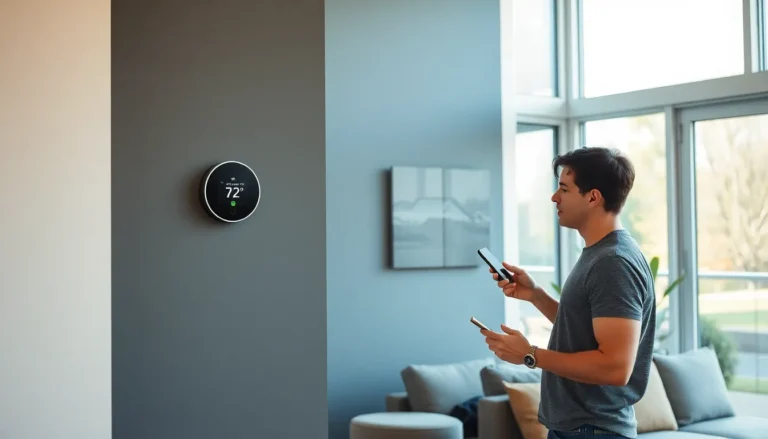Table of Contents
ToggleImagine a world where your windows do the talking—well, kind of. Smart window sensors are the unsung heroes of modern homes, quietly working in the background to keep your living space comfortable and energy-efficient. These nifty gadgets not only alert you to open windows but also help manage your home’s climate, all while saving you from those pesky energy bills. Who knew a little sensor could pack such a punch?
Overview of Smart Window Sensors
Smart window sensors play a crucial role in home automation. These devices monitor window status, providing real-time notifications when a window opens or closes. Homeowners can leverage this information to enhance security, prevent energy waste, and improve climate control.
Energy efficiency stands out as one of the primary advantages of smart window sensors. By receiving alerts about open windows, residents can adjust heating or cooling systems accordingly. This adjustment helps maintain optimal indoor temperatures while reducing energy costs.
Another key benefit involves safety features. Smart sensors can be integrated into security systems. If a window remains open unexpectedly, the system alerts the homeowner, potentially deterring intruders.
Smart window sensors also promote convenience. Homeowners can access data through mobile applications. These applications allow users to monitor their windows remotely, giving them peace of mind when away from home.
Integration with other smart devices enhances functionality. For instance, connecting sensors to smart thermostats enables automatic adjustments based on window status. This connectivity streamlines overall climate management.
The installation process varies depending on the model. Some sensors require professional installation, while others allow for DIY setups. Ensuring compatibility with existing window structures is essential for optimal performance.
Smart window sensors represent an innovative solution for modern living. They address energy management, security, and convenience, catering to the needs of today’s homeowners. These devices integrate seamlessly into smart home ecosystems, making them a notable addition to any contemporary residence.
Benefits of Smart Window Sensors
Smart window sensors offer various advantages for modern homes, enhancing comfort, security, and energy efficiency.
Energy Efficiency
Smart window sensors contribute significantly to energy efficiency. These devices provide real-time notifications when windows are open, allowing homeowners to manage heating and cooling systems effectively. By closing open windows in response to outside temperatures, users prevent unnecessary energy loss. According to studies, incorporating these sensors can lower energy costs by up to 30%. Furthermore, integration with smart thermostats ensures that climate control adjusts according to real-time conditions. Homeowners benefit from an optimized indoor environment, reducing reliance on heating and air conditioning.
Enhanced Security
Enhanced security stands out as a critical benefit of smart window sensors. These devices monitor the status of windows and provide alerts of any unexpected openings. Integration with existing security systems empowers homeowners to receive immediate notifications on their mobile devices. Many models enable remote monitoring, allowing users to check window status anytime. Studies show that homes equipped with smart security systems experience fewer break-ins. Peace of mind increases when families receive alerts while away, deterring potential intruders. Overall, smart window sensors enhance both safety and home security.
Types of Smart Window Sensors
Smart window sensors come in various types, each designed to address specific needs in home security and energy management. Two common types include contact sensors and motion sensors.
Contact Sensors
Contact sensors detect when a window opens or closes, providing immediate alerts to homeowners. Installation usually involves placing one part on the window frame and the other on the window itself. Homeowners benefit from real-time notifications, allowing them to take action if a window is unexpectedly opened. These sensors integrate seamlessly with security systems, enhancing overall safety. Studies show that contact sensors effectively reduce energy waste by ensuring windows are closed when not in use, which aids in climate control.
Motion Sensors
Motion sensors track movement near windows, providing another layer of security. They often use infrared technology to monitor activity, alerting homeowners to potential intruders. With the ability to distinguish between pets and humans, motion sensors reduce false alarms. These devices also contribute to energy efficiency by detecting when rooms are unoccupied, prompting heating or cooling systems to adjust accordingly. Routine updates enable homeowners to manage their environments more effectively, ensuring comfort and security simultaneously.
Installation and Setup
Installing smart window sensors typically requires minimal effort. First, determine the appropriate location for the sensors on each window. Mounting brackets or adhesive strips often accompany the sensors, allowing for flexible installation. One common option includes connecting sensors directly to the window frame to detect movement accurately.
Before installation, ensure the windows are clean and dry to improve adhesion. Read the manufacturer’s instructions thoroughly for specific steps related to the chosen model. Some devices connect via Wi-Fi or Bluetooth, necessitating a stable internet connection during setup.
For those opting for DIY installations, basic tools—such as a screwdriver and level—might be necessary. A typical installation takes about 30 minutes for each window, depending on complexity. Connect the sensors to the home network using the dedicated mobile app provided by the manufacturer for real-time monitoring.
Following setup, adjust the notifications and alerts according to personal preferences through the app. Regularly check for software updates to ensure optimal performance. Integration with existing smart home systems enhances the overall functionality while providing a seamless user experience.
In cases where professional installation seems preferable, hiring a qualified technician becomes an option. Professionals ensure proper placement, alignment, and connectivity while reducing troubleshooting time. Installation costs typically range between $50 and $150, depending on the number of windows and service type.
Maintaining the sensors is equally crucial. Regularly inspect the devices for wear and tear to ensure consistent performance. Keeping windows and sensors clean contributes to their longevity. Overall, successful installation and ongoing maintenance maximize the benefits of smart window sensors in enhancing home efficiency and security.
Compatibility with Smart Home Systems
Smart window sensors integrate seamlessly with popular smart home systems, enhancing their functionality. These sensors often support platforms like Google Assistant, Amazon Alexa, and Apple HomeKit, allowing for effortless voice commands and automation. Connectivity usually relies on Wi-Fi or Zigbee, enabling smooth communication with other devices.
Homeowners appreciate the ability to create customized routines. For instance, residents can set their lights to turn off automatically when windows are opened. This feature minimizes energy waste and contributes to a more efficient home environment.
Many smart window sensors also connect with security systems, providing alerts for unexpected window status changes. Integrating these sensors with existing security cameras further bolsters home safety. Notifications can be sent directly to smartphones, offering peace of mind when away from home.
Compatibility extends to smart thermostats; when windows open, thermostats can adjust temperatures accordingly. This interaction enhances energy efficiency by optimizing heating and cooling based on real-time conditions.
Installation simplicity enhances compatibility with smart home systems. Most sensors allow easy connection to a central hub, streamlining setup and enhancing overall system performance. Homeowners often find it beneficial to consult product manuals for specific pairing instructions.
Regular updates improve device compatibility over time, ensuring that smart window sensors function optimally with evolving technology. New features might be introduced through firmware updates, pushing notifications to maintain connectivity.
Understanding compatibility helps users make informed decisions when selecting smart window sensors. Potential buyers should consider their existing smart home ecosystem, ensuring their choices align with desired functionalities. Prioritizing device compatibility elevates the overall smart home experience, maximizing user satisfaction and energy savings.
Conclusion
Smart window sensors are transforming how homeowners manage energy efficiency and security. By providing real-time notifications and seamless integration with other smart devices, they enhance convenience and peace of mind. Their ability to monitor window status not only helps in climate management but also deters potential intruders, making homes safer.
With easy installation options and compatibility with popular smart home systems, these sensors offer a practical solution for modern living. Regular maintenance ensures they continue to perform at their best, maximizing the benefits they bring. Embracing smart window sensors is a step toward a more efficient and secure home environment.








